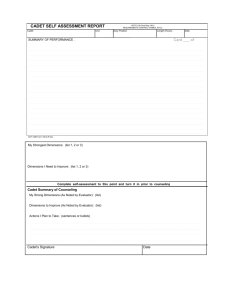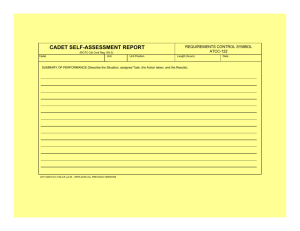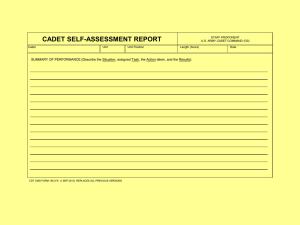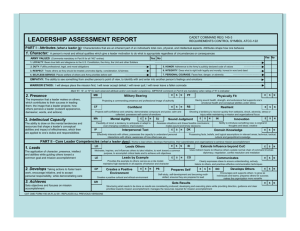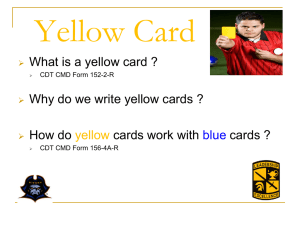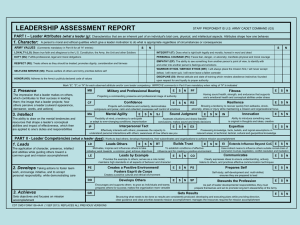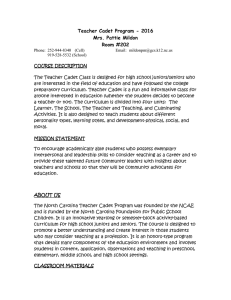Faculty Development Course
advertisement
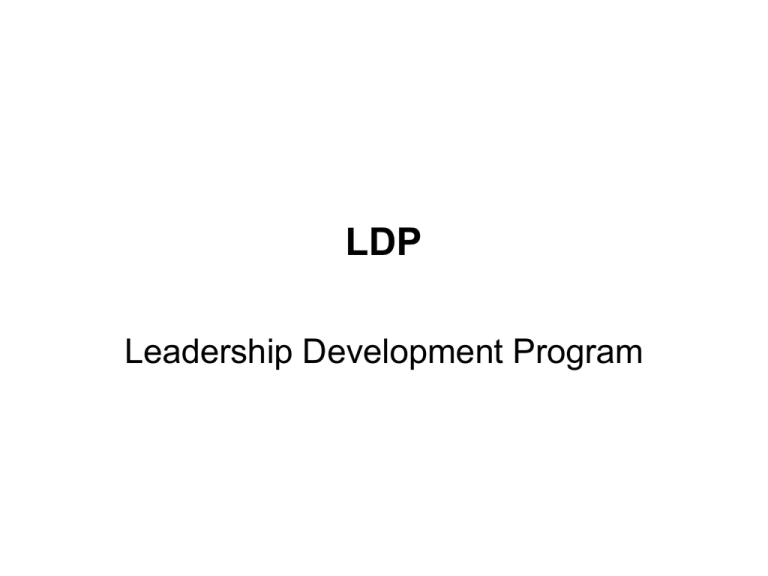
LDP Leadership Development Program LEADERSHIP DEVELOPMENT PROGRAM (LDP) LEADERSHIP DEVELOPMENT PROGRAM DEFINED: A CONTINUOUS PROCESS OF TRAINING, ASSESSMENT AND FEEDBACK IN A VARIETY OF TRAINING ENVIRONMENTS •PURPOSE: INSTILLING AND ENHANCING DESIRABLE BEHAVIOR IN MILITARY LEADERS •FEATURES: • STANDARDIZED ASSESSMENT TECHNOLOGY • INDIVIDUAL FOCUS • STRUCTURED LEADERSHIP OPPORTUNITIES • PROVIDES DEVELOPMENTAL FEEDBACK •ASSESSOR QUALIFICATION • PEER RATINGS • LINK TO ACCESSIONS What is the LDP? • LDP is comprised of 16 leadership dimensions and 7 value dimensions • Cadets are evaluated on a minimum of 5 leadership positions on campus and at LDAC • Enables the production of both on campus and LDAC CER’s LDP OPERATIONAL MODEL MS I&II 1st Semester Campus + 2d Semester 67-9-1 67-9-1A (DA Form 4856) + Blue Card CER JPSC Campus Development Plan CER MS III Campus + CCF 7010 CCF 7011 Camp Camp MS IV Blue Card 67-9-1 67-9-1A Development Plan + OER 2nd Sem Scored Events CER Camp Accessions Packet LEADERSHIP DEVELOPMENT PROGRAM CER ACCESSIONS ASSESS RECOGNIZE TRAIN BEHAVIOR RECORD COUNSEL CLASSIFY RATE PROCESS OF ASSESSMENT LEADERSHIP DEVELOPMENT PROGRAM RECOGNIZING BEHAVIOR • CRITICAL VS NON-CRITICAL BEHAVIOR • CRITICAL - Significant impact on current or future leader effectiveness •NON-CRITICAL – Little, if any, impact on leader effectiveness • DIRECT AND INDIRECT OBSERVATION • DIRECT – Observed behavior causes results • INDIRECT – Observed results imply behavior occurred • FIRST- AND SECONDHAND OBSERVATION • FIRSTHAND – Personally Noted • SECONDHAND – Behavior Related by Another RECORDING BEHAVIOR • Written or mental notes • Recommend detailed, organized notes • Enhance developmental counseling • Facilitate quick reference to support summary statement and CER development, and performance board and PMS inquires • Every note should have a purpose • Record only critical behavior • Summarize recurring behavior (communication, technical, physical, etc.) rather than recording every instance MANAGEMENT TOOLS CADET SELF ASSESSMENT REPORT Cadet Unit ROTC Cdt Cmd Reg 145-3 REQUIREMENTS CONTROL SYMBOL ATCC-122 Duty Position Length(Hours) SUMMARY OF PERFORMANCE (Describe the Situation, assigned Task, the Action taken, and the Results). CDT CMD Form 156-2-R Dec 95 Cadet Self-Assessment Report (Front) Date Card ___ of ___ MANAGEMENT TOOLS My Strongest Dimensions: (list 1, 2 or 3 ) Dimensions I Need to Improve: (list 1, 2 or 3 ) Complete self-assessment to this point and turn it in prior to counseling Cadet Summary of Counseling My Strong Dimensions (As Noted by Evaluator): (list ) Dimensions to Improve (As Noted by Evaluator): (list ) Actions I Plan to Take: (sentences or bullets) Cadet’s Signature Date CC Form 156-2-R (Reverse Side) Jun 97 Cadet Self-Assessment Report (Reverse) MANAGEMENT TOOLS CADET COMMAND REG 145-3 REQUIREMENTS CONTROL SYMBOL ATCC-122 LEADERSHIP ASSESSMENT REPORT PART I – RECORD OF OBSERVATIONS AND COUNSELING Check here if SPOT REPORT a. SUMMARY OF OBSERVATION: Summarize most significant observed leadership behaviors. Use sufficient detail to support summary ratings in Parts II and III. Use Continuation Card if necessary. b. COUNSELING: Comment on at least 1 “SUSTAIN” and 1 “IMPROVE” dimension as identified in Part II. (“IMPROVE” comments are required for each “N” entry in Part II) Not required for Spot Report. SUSTAIN: IMPROVE: UNIT RATED CADET NAME RATED CADET SIGNATURE ASSESSOR NAME / INITIALS CDT CMD FORM 156-4A-R FEB 02 REPLACES CDT CMD FORM 156-4-R OCT 98 DUTY POSITION (Location if Spot Report) DATE CADRE CADET NOTE: Signature indicates that counseling was administered as reflected in Part 1b above, and does not imply agreement with ratings. Leadership Assessment/Spot Report (Front) MANAGEMENT TOOLS PART II - CHARACTER: Disposition of the leader: combination of values, attributes, and skills affecting leader actions a. ARMY VALUES (Comments mandatory for all “NO” entries. Use Part I.) 1. LOYALTY: Bears true faith and allegiance to the U.S. Constitution, the Army, Yes No Yes No the Unit, and the soldier 2. DUTY: Fulfills professional, legal, and moral obligations 3. RESPECT: Promotes dignity, consideration, fairness, & EO 4. SELFLESS-SERVICE: Places Army priorities before self 5. HONOR: Adherence to the Army’s publicly declared code of values 6. INTEGRITY: Possesses high personal moral standards; honest in word and deed 7. PERSONAL COURAGE: Manifests physical and moral bravery b. LEADER ATTRIBUTES / SKILLS / ACTIONS: Mark “E”, “S”, or “N” for each observed dimension. IMPROVE comments in Part II are mandatory when rating of “N” is indicated. 1. ATTRIBUTES Fundamental qualities and characteristics 2. SKILLS Skill development is part of self-development; prerequisite to action ME MENTAL E S N PH Possesses desire, will, initiative and discipline CN CONCEPTUAL E S N IP Demonstrates sound judgment, critical/creative thinking, moral reasoning TA PHYSICAL E S N EM Maintains appropriate level of physical fitness and military bearing INTERPERSONAL E EMOTIONAL E S N S N E S N E S N E S N E S N Displays self-control; calm under pressure S N TE TECHNICAL E Possesses the necessary expertise to accomplish all tasks and functions Shows skill with people; coaching, teaching, counseling, motivating and empowering TACTICAL Demonstrates proficiency in required professional knowledge, judgment, and warfighting 3. ACTIONS Major activities leaders perform; influencing, operating and improving INFLUENCING Method of reaching goals while operating/improving OPERATING Short-term mission accomplishment IMPROVING Long-term improvement in the Army, its people, and organizations CO COMMUNICATING E S N Displays good oral, written, and listening skills for individual / groups PL PLANNING E DEVELOPING E Invests adequate time and effort to develop individual subordinates as leaders DECISION-MAKING E S N Employs sound judgment, logical reasoning, and uses resources wisely S N Develops detailed, executable plans that are feasible, acceptable, and suitable DE DM EX EXECUTING E MO Inspires, motivates, and guides others toward mission accomplishment S N AS N BD BUILDING E Spends time and resources improving teams, groups, and units; fosters ethical climate PART III - OVERALL NET ASSESSMENT (Circle one) Leadership Assessment/Spot Report (Reverse) E ASSESSING Uses after-action and evaluation tools to facilitate consistent improvement Shows tactical proficiency, meets mission standards, and takes care of people / resources S MOTIVATING S N LR LEARNING Seeks self-improvement and organizational growth; envisioning, adapting and leading S N MANAGEMENT TOOLS JOB PERFORMANCE SUMMARY CARD Cadet SSN Unit School VALUES Date Position Assessor As Obsvd ATTRIBUTES ME PH EM SKILLS CN IP TE TA INFLUENCING OPERATING CO DM PL MO EX AS IMPROVING DE BD LR NET Summary of Ratings by Dimension APFT: PU RUN SU TOTAL LAND NAV: WR NT DY BRM: TOTAL ROTC CDT CMD FORM 156-18A-R Job Performance Summary Card (Cadet Focused) (Front) SQUAD PEER: ______OF______ RECONDO: YES NO PEER EVALUATION REPORT (ROTC Cdt Cmd Reg 145-3) CADET (RATER) I II REQUIREMENTS CONTROL SYMBOL (Check one) ATCC-122 UNIT DATE CADET (RATED) RANKING________________OF_____________ WHAT ARE THIS INDIVIDUAL’S STRONGEST (ONE, TWO, OR THREE) LEADERSHIP DIMENSIONS AND WHY? WHAT ARE THIS INDIVIDUAL’S WEAKEST (ONE, TWO, OR THREE) LEADERSHIP DIMENSIONS AND WHY? CDT CMD Form 156-17-R Feb 96 CLASSIFYING BEHAVIOR VALUES Loyalty - Duty - Respect Selfless Service - Honor Integrity - Personal Courage Mental ATTRIBUTES - Physical - Emotional SKILLS Conceptual - Interpersonal Technical - Tactical ACTIONS Influencing: Communicating - Decision Making - Motivating Operating: Planning Executing Assessing Improving: Developing Building Learning RATING BEHAVIOR BASE THE NET ASSESSMENT ON HOW EFFECTIVE YOU THOUGHT THE LEADER WAS OVERALL EVALUATOR AND SUBORDINATES ARE MAKING THE SAME (GUT) ASSESSMENT (ONLY DIFFERENCE--EVALUATOR’S ASSESSMENT IS BACKED UP WITH DIMENSIONAL FEEDBACK) Excellent - Above what you reasonably expect of a cadet Satisfactory - What you reasonably expect of a cadet Needs Improvement - Below what you reasonably expect of a cadet RATING BEHAVIOR SATISFACTORY STANDARDS: Usually generates reasonable courses of action… - ME Adequately shows self-confidence… - EM Generally conveys ideas… - CO Attempts to balance resolve… - DM Reasonably adheres to “1/3-2/3 Rule”… - PL Generally shows accountability… - EX Attempt to meet subordinate’s needs…- MO POINTS TO REMEMBER: •Evaluating based on what we expect of cadets—not officers and NCO’s •Satisfactory ratings allow room for mistakes •Beware dimensional N’s based on one negative observation RATING BEHAVIOR RATE EACH LEADERSHIP DIMENSION ACCORDING TO THE LEADERSHIP PERFORMANCE INDICATORS USING THE FOLLOWING SYSTEM: OBSERVATIONS EXECUTED INDICATED BY POSITIVE E GENERALLY NEUTRAL S or E NEGATIVE S or N SUMMARY STATEMENT DEVELOPMENT A narrative summary (word picture) of total performance during the observed period. PAINTING THE PICTURE •THE BLUE CARD • Write the summary in the same manner you would describe what the cadet just did to one of your peers--Write what you see! • Well written summary statements: • Facilitate quick, effective counseling by highlighting critical dimensional behavior • Tell the Platoon TAC Team, MS III Instructor and PMS what happened • Provide a record of counseling • Help build the cadet’s CER SUMMARY STATEMENT DEVELOPMENT Bottom Line Up Front – First sentence is a quantified statement of the cadet’s overall leadership effectiveness Use the remainder of summary used to address critical leadership behavior Include consistency, growth, challenges faced, level of difficulty of position held, etc. to help “paint the picture” Use the statement to send a message to the cadet and his/her cadre (TACs & PMS) Clearly spell out justification for “N” dimensional ratings; justification should consist of more than one observation Do not attempt to write a chronological series of action statements Do not address insignificant or non-critical behavior THE BLUE CARD LEADERSHIP ASSESSMENT REPORT CADET COMMAND REG 145-3 REQUIREMENTS CONTROL SYMBOL ATCC-122 PART I – RECORD OF OBSERVATIONS AND COUNSELING Check here if SPOT REPORT a. SUMMARY OF OBSERVATION: Summarize most significant observed leadership behaviors. Use sufficient detail to support summary ratings in Parts II and III. Use Continuation Card if necessary. Cadet Taylor’s energy and enthusiasm were instrumental in the success of the company. His outstanding ability to react to unexpected changes in the company commander’s guidance was critical to the company’s meeting SP time. Subordinates recognized his rapid reaction and responded in kind. Throughout the day, he faithfully supported an indecisive company commander, tactfully guiding him at times to the correct decision. Maintained the same level of energy and appearance throughout the day in spite of lack of sleep the previous night due to inclement weather. Cadet Taylor continues to show improvement in dealing with subordinates. Good job of working with the 2d Plt Sgt on PCIs. b. COUNSELING: Comment on at least 1 “SUSTAIN” and 1 “IMPROVE” dimension as identified in Part II. (“IMPROVE” comments are required for each “N” entry in Part II) Not required for Spot Report. SUSTAIN: CN - Rapidly solves critical issues DM - Demonstrated resolve energizes subordinates into action AS – Constantly seeks ways to improve ongoing operations IMPROVE: IP – Need to demonstrate greater patience when dealing with subordinates. You tend to show frustration with what you consider “dumb” questions RATED CADET NAME Taylor, Brian RATED CADET SIGNATURE UNIT 3A1 ASSESSOR NAME / INITIALS Jeffrey L. Jacobs CDT CMD FORM 156-4A-R FEB 02 REPLACES CDT CMD FORM 156-4-R OCT 98 DUTY POSITION (Location if Spot Report) 1SG JLJ DATE 5 Jun 02 CADRE CADET X NOTE: Signature indicates that counseling was administered as reflected in Part 1b above, and is not intended to imply agreement with ratings. BLUE CARD – VERSION 1 PART II - CHARACTER: Disposition of the leader: combination of values, attributes, and skills affecting leader actions a. ARMY VALUES (Comments mandatory for all “NO” entries. Use Part I.) 1. LOYALTY: Bears true faith and allegiance to the U.S. Constitution, the Army, Yes No Yes No the Unit, and the soldier 2. DUTY: Fulfills professional, legal, and moral obligations 3. RESPECT: Promotes dignity, consideration, fairness, & EO 4. SELFLESS-SERVICE: Places Army priorities before self 5. HONOR: Adherence to the Army’s publicly declared code of values 6. INTEGRITY: Possesses high personal moral standards; honest in word and deed 7. PERSONAL COURAGE: Manifests physical and moral bravery X b. LEADER ATTRIBUTES / SKILLS / ACTIONS: Mark “E”, “S”, or “N” for each observed dimension. IMPROVE comments in Part II are mandatory when rating of “N” is indicated. 1. ATTRIBUTES Fundamental qualities and characteristics 2. SKILLS Skill development is part of self-development; prerequisite to action ME MENTAL E X S N PH Possesses desire, will, initiative and discipline CN CONCEPTUAL E X S N IP Demonstrates sound judgment, critical/creative thinking, moral reasoning TA PHYSICAL E X S N EM Maintains appropriate level of physical fitness and military bearing INTERPERSONAL E EMOTIONAL E X S N S X N E S N E X S N E S X N E S X N Displays self-control; calm under pressure S X N TE TECHNICAL E Possesses the necessary expertise to accomplish all tasks and functions Shows skill with people; coaching, teaching, counseling, motivating and empowering TACTICAL Demonstrates proficiency in required professional knowledge, judgment, and warfighting 3. ACTIONS Major activities leaders perform; influencing, operating and improving INFLUENCING Method of reaching goals while operating/improving OPERATING Short-term mission accomplishment IMPROVING Long-term improvement in the Army, its people, and organizations CO COMMUNICATING E S X N Displays good oral, written, and listening skills for individual / groups PL PLANNING E DEVELOPING E Invests adequate time and effort to develop individual subordinates as leaders DECISION-MAKING E S N Employs sound judgment, logical reasoning, and uses resources wisely S N Develops detailed, executable plans that are feasible, acceptable, and suitable DE DM EX EXECUTING E X MO Inspires, motivates, and guides others toward mission accomplishment S N AS N BD BUILDING E Spends time and resources improving teams, groups, and units; fosters ethical climate PART III - OVERALL NET ASSESSMENT (Circle one) E ASSESSING Uses after-action and evaluation tools to facilitate consistent improvement Shows tactical proficiency, meets mission standards, and takes care of people / resources S MOTIVATING S N LR LEARNING Seeks self-improvement and organizational growth; envisioning, adapting and leading S N BLUE CARD – VERSION 1 LEADERSHIP ASSESSMENT REPORT CADET COMMAND REG 145-3 REQUIREMENTS CONTROL SYMBOL ATCC-122 PART I – RECORD OF OBSERVATIONS AND COUNSELING Check here if SPOT REPORT a. SUMMARY OF OBSERVATION: Summarize most significant observed leadership behaviors. Use sufficient detail to support summary ratings in Parts II and III. Use Continuation Card if necessary. Bass demonstrated the necessary expertise to successfully lead his team and was instrumental in his team’s success. He completed all assigned tasks to standard, and showed good initiative and analytical skills. Bass persevered in the face of adversity and gained the trust and support of his subordinates. During the leadership opportunity, Bass successfully accomplished tasks that he had previously struggled with. Bass performance reflects great credit upon himself, his cadre and his unit. b. COUNSELING: Comment on at least 1 “SUSTAIN” and 1 “IMPROVE” dimension as identified in Part II. (“IMPROVE” comments are required for each “N” entry in Part II) Not required for Spot Report. CN – Created a solution to a serious problem confronting his unit PH – Exhibited great physical strength MO – Fired up his subordinates EM – Remained calm under pressure IMPROVE: SUSTAIN: TE – Continue to practice individual tasks RATED CADET NAME Bass, Ronnie RATED CADET SIGNATURE UNIT Titans ASSESSOR NAME / INITIALS William C. Roebuck CDT CMD FORM 156-4A-R FEB 02 REPLACES CDT CMD FORM 156-4-R OCT 98 DUTY POSITION (Location if Spot Report) QB WCR DATE 5 Nov 02 CADRE CADET X NOTE: Signature indicates that counseling was administered as reflected in Part 1b above, and is not intended to imply agreement with ratings. COUNSELING COUNSELING - “ Subordinate-centered communication that produces a plan outlining actions necessary for subordinates to achieve individual or organizational goals” FM 22-100 COUNSELING DISCUSSION Goal: Improve cadet performance through constructive, effective, timely feedback Do’s? Don’ts? Tips and Techniques? COUNSELING POSSIBLE CADET REACTIONS TO COUNSELING • DENIAL • NERVOUSNESS • RATIONAL DISAGREEMENT • “TOO EASY” AGREEMENT • ATTEMPTS TO SHIFT BLAME • LOSS OF TEMPER • DESIRE TO QUIT • CRYING CER The CER is an LDP developmental counseling tool that mirrors the Officer Efficiency Report (OER). It is designed to utilize information generated by the LDP to provide constructive feedback to cadets on-campus and at LDAC. 7 Values 16 Leadership Dimensions PLT TAC Overall Rating E/S/N PLT TAC Bullet Comments LEADERSHIP DEVELOPMENT PROGRAM (LDP)
